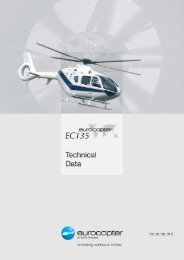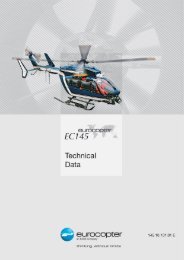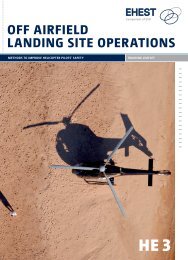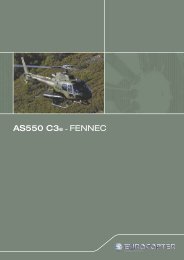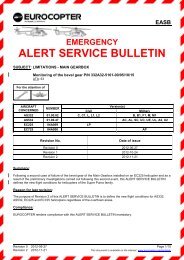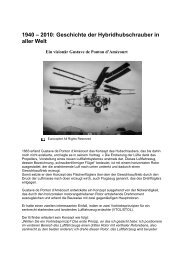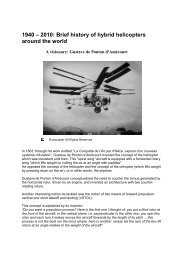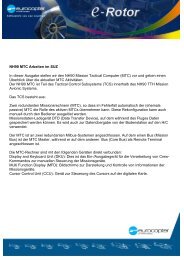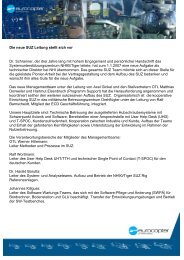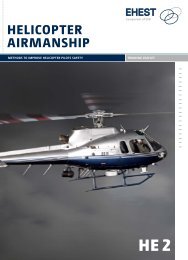Rotor - Eurocopter
Rotor - Eurocopter
Rotor - Eurocopter
You also want an ePaper? Increase the reach of your titles
YUMPU automatically turns print PDFs into web optimized ePapers that Google loves.
maintenance and technical support capacities.<br />
“DOCTOR HELI”<br />
Japan’s National Air Rescue System<br />
Nearly a decade has passed since a Helicopter Emergency Medical System<br />
(HEMS) was established in Japan and the “Doctor Heli” program went into service.<br />
Since then, 10 EC135s have been helping to save lives. This is an exemplary success story<br />
in a market which still exhibits great growth potential.<br />
In October 1999, the Japanese HEMS organization HEM-Net (1)<br />
launched the “Doctor Heli” program on a trial basis in the<br />
Japanese provinces of Okayama and Kanagawa. “Two years<br />
later the official go-ahead was given for the program, which was<br />
unique in North Asia. It was essentially based on the ADAC’s model<br />
introduced in Germany in 1970,” explains Michael Rudolph, head<br />
of market development for public services and EMS. In addition<br />
to their primary role of transporting accident victims to hospitals<br />
and emergency-response physicians to accident scenes, the<br />
“Doctor Helis” are now also increasingly handling secondary<br />
transportation to and from specialized clinics and taking part in<br />
disaster relief work.<br />
A Reference in Asia<br />
To date, 16 of Japan’s 47 provinces have deployed a total of<br />
22 helicopters (including ten EC135s and seven BK117s). “The<br />
excellent rear loading capability was crucial in their selection,”<br />
emphasize HEM-Net Directors W. Nishikawa and Y.Yamano.<br />
The “Doctor Helis” have become an important component of the<br />
© Na Nakani Na Nakanihon<br />
o Airservi ervi v ce c<br />
ARTICLE: REGINA R A LANGE<br />
EMS INVOLMENT<br />
From the outset, the focus of <strong>Eurocopter</strong>’s<br />
involvement has not only been on providing<br />
suitable platforms, but also on supporting the<br />
participating organizations and emergency<br />
medical institutions, including the Japanese<br />
Ministry of Health, Labor and Welfare, as a<br />
partner in their work, by organizing HEMS<br />
symposiums and forums with the assistance<br />
of the European HEMS and Air Ambulance<br />
Committee (EHAC).<br />
23<br />
Japanese health system: The death rate for accident victims has<br />
dropped by 40% and the number of patients saved is twice as<br />
high as by road with ambulance transportation. Nevertheless,<br />
better coordination is needed between the different authorities<br />
and agencies within the rescue service, and additional “Doctor<br />
Heli” projects must be implemented in the remaining 31 provinces<br />
to make national air rescue and emergency-response treatment<br />
more efficient and to ensure optimal provision for the entire<br />
population.<br />
“The ‘Doctor Heli’ program is regarded as the benchmark for air<br />
rescue, not just in Japan, but throughout North Asia. This zone<br />
has great growth potential,” explains Michael Rudolph.<br />
“For 2009, the Japanese government has provided a budget that<br />
enables six additional HEMS stations to be set up. If a similar<br />
budget is available next year, the 30th station could be inaugurated<br />
by the end of 2010,” predict W. Nishikawa and Y.Yamano. ■<br />
(1) Helicopter and Hospital EMS Network (Japan’s national HEMS organization)<br />
R OTOR JOURNAL - NO. 83 - OCTOBER/ NOVEMBER 2009



